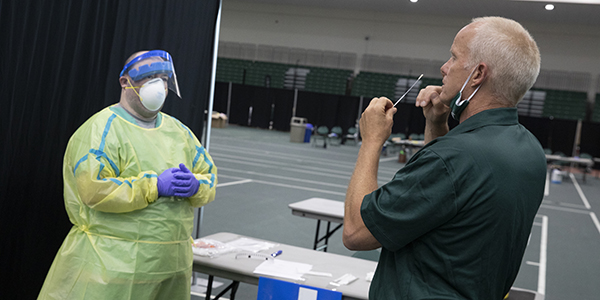Surveillance testing is underway in Old Union Hall

Surveillance testing for COVID-19 began Sept. 2 at Binghamton University. The testing, which will be conducted throughout the semester, looks at samples of the campus population, rather than testing everyone, to try to identify problem areas or potential hot spots for spreading the virus.
“The purpose of an active surveillance program is to identify the presence of COVID-19 as early as possible,” said David Hubeny, executive director of emergency management for the campus. “By actively seeking out instances of the virus in our community, we expect to be able to intervene before significant spread occurs. Surveillance testing combined with community compliance through social distancing and mask wearing provides the best opportunity to finish the semester without significant interruption.”
Nearly 450 students have been tested as of this publication date, but that number is expected to grow to about 200 a day, and to include faculty and staff beginning the week of Sept. 14, Hubeny said. Of those tested to date, two students received positive results and are isolated.
As the process continues, individuals selected for testing are being notified 48 hours in advance and asked to register through B-Engaged for a two-hour time slot that is convenient for them. Walk-in testing cannot be accommodated. “Everyone receiving a test must have an appointment scheduled prior to arriving,” Hubeny said.
The testing includes students from both on and off campus, said Kimberly Yousey-Elsener, director of student affairs assessment. Her office is overseeing the selection and notification to students. In fact, the email students receive notifying them of their selection comes directly from her.
“We’re doing stratified random samples,” she said, explaining that the majority of students will be selected randomly, but if a problem area is found in a residence hall or neighborhood, for example, it will be weighted to draw more test subjects from that area.
If a student asks for an exemption from the testing, Yousey-Elsener looks into it. “If, for example, it’s a PhD student registered for one credit, but living in Pittsburgh, I can pull that student out of the sample,” she said.
Without an exemption, there are repercussions for students who fail to show after two attempts to schedule them. Failure to show for testing on the second scheduled date will result in disciplinary action pursuant to the rights and responsibilities document all students acknowledged. Penalties can include denial of access to campus and loss of housing. Persistent noncompliance will result in a referral to the disciplinary process, which can result in the suspension of the student from the University.
The campus is using the same rapid results test it used for the residential students prior to move in — the BD Veritor system. “We will likely be supplementing our program with pooled testing as well,” Hubeny said. “Additionally, our surveillance program includes wastewater testing and the daily online screening of students and employees.”
Results from the test, which uses a nasal swab, are typically received within 30 minutes and a text message is sent with a link to the individuals directing them to their results.
Students who test positive are notified directly by staff working at the site, said Johann Fiore-Conte, associate vice president for student affairs. “Options for isolation are discussed and medical and public health information is provided to them,” she said. “There is also follow-up to this conversation with a list of resources that might be of help to the student related to such things as making academic adjustments, contacting the CARE Team and other resources.
“While students are encouraged to isolate at home, there are designated spaces on campus for isolation/quarantine for students unable to travel home,” Fiore-Conte added. “Should students decide to stay on campus, there are staff assigned to the isolation/ quarantine area who assist students in transitioning in and out of the space and provide support during their isolation/quarantine period.”
As did the testing of residential students prior to their move in, surveillance testing relies on collaboration across campus, Hubeny said. “The information technology infrastructure necessary to carry out the testing is vital to its success. The IT support and troubleshooting we’ve had allows us to be successful with this entire process,” he said.
Staffing is also key, Hubeny added. The testing site, in Old Union Hall in the University Union, was able to get underway with assistance from a number of volunteers until temporary employees could be brought on.
Updated test results can be found on the University’s COVID-19 dashboard.

